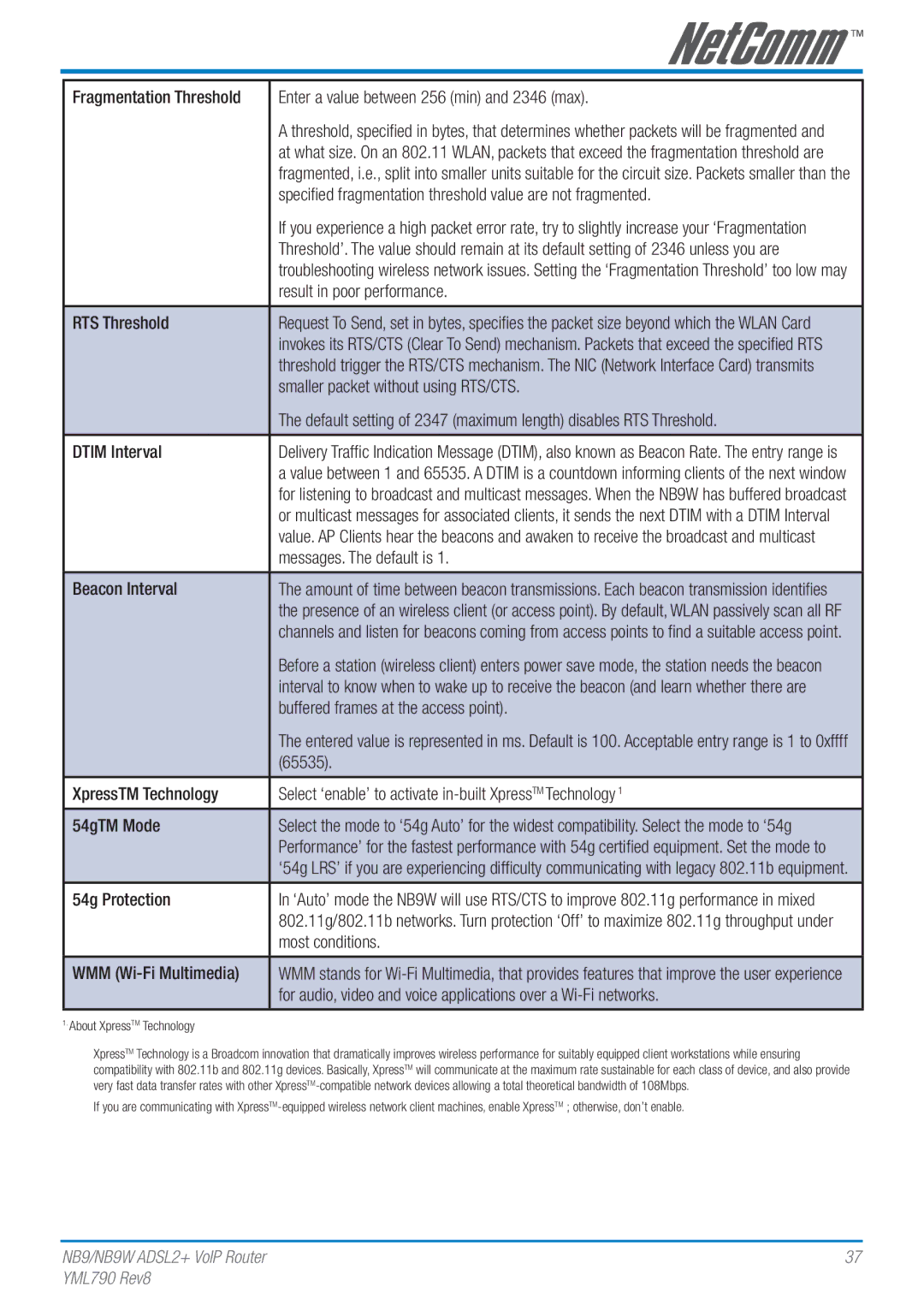
Fragmentation Threshold | Enter a value between 256 (min) and 2346 (max). |
| A threshold, specified in bytes, that determines whether packets will be fragmented and |
| at what size. On an 802.11 WLAN, packets that exceed the fragmentation threshold are |
| fragmented, i.e., split into smaller units suitable for the circuit size. Packets smaller than the |
| specified fragmentation threshold value are not fragmented. |
| If you experience a high packet error rate, try to slightly increase your ‘Fragmentation |
| Threshold’. The value should remain at its default setting of 2346 unless you are |
| troubleshooting wireless network issues. Setting the ‘Fragmentation Threshold’ too low may |
| result in poor performance. |
|
|
RTS Threshold | Request To Send, set in bytes, specifies the packet size beyond which the WLAN Card |
| invokes its RTS/CTS (Clear To Send) mechanism. Packets that exceed the specified RTS |
| threshold trigger the RTS/CTS mechanism. The NIC (Network Interface Card) transmits |
| smaller packet without using RTS/CTS. |
| The default setting of 2347 (maximum length) disables RTS Threshold. |
|
|
DTIM Interval | Delivery Traffic Indication Message (DTIM), also known as Beacon Rate. The entry range is |
| a value between 1 and 65535. A DTIM is a countdown informing clients of the next window |
| for listening to broadcast and multicast messages. When the NB9W has buffered broadcast |
| or multicast messages for associated clients, it sends the next DTIM with a DTIM Interval |
| value. AP Clients hear the beacons and awaken to receive the broadcast and multicast |
| messages. The default is 1. |
|
|
Beacon Interval | The amount of time between beacon transmissions. Each beacon transmission identifies |
| the presence of an wireless client (or access point). By default, WLAN passively scan all RF |
| channels and listen for beacons coming from access points to find a suitable access point. |
| Before a station (wireless client) enters power save mode, the station needs the beacon |
| interval to know when to wake up to receive the beacon (and learn whether there are |
| buffered frames at the access point). |
| The entered value is represented in ms. Default is 100. Acceptable entry range is 1 to 0xffff |
| (65535). |
|
|
XpressTM Technology | Select ‘enable’ to activate |
|
|
54gTM Mode | Select the mode to ‘54g Auto’ for the widest compatibility. Select the mode to ‘54g |
| Performance’ for the fastest performance with 54g certified equipment. Set the mode to |
| ‘54g LRS’ if you are experiencing difficulty communicating with legacy 802.11b equipment. |
|
|
54g Protection | In ‘Auto’ mode the NB9W will use RTS/CTS to improve 802.11g performance in mixed |
| 802.11g/802.11b networks. Turn protection ‘Off’ to maximize 802.11g throughput under |
| most conditions. |
|
|
WMM | WMM stands for |
| for audio, video and voice applications over a |
|
|
1.About XpressTM Technology
XpressTM Technology is a Broadcom innovation that dramatically improves wireless performance for suitably equipped client workstations while ensuring compatibility with 802.11b and 802.11g devices. Basically, XpressTM will communicate at the maximum rate sustainable for each class of device, and also provide very fast data transfer rates with other
If you are communicating with
NB9/NB9W ADSL2+ VoIP Router | 37 |
YML790 Rev8 |
|
